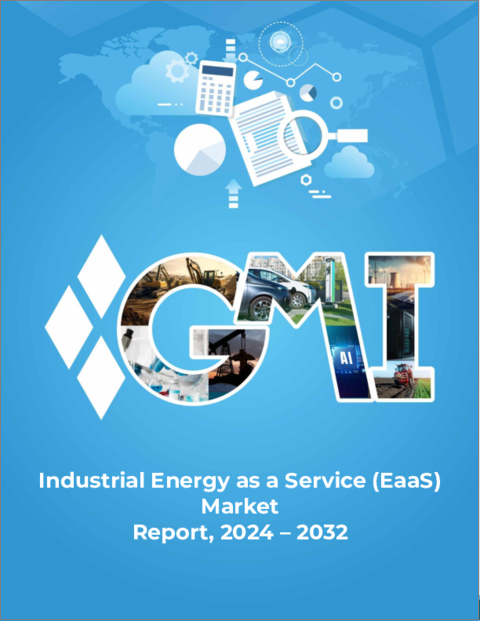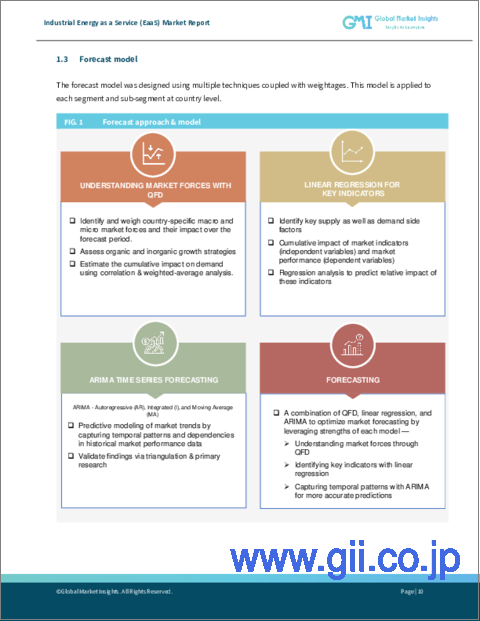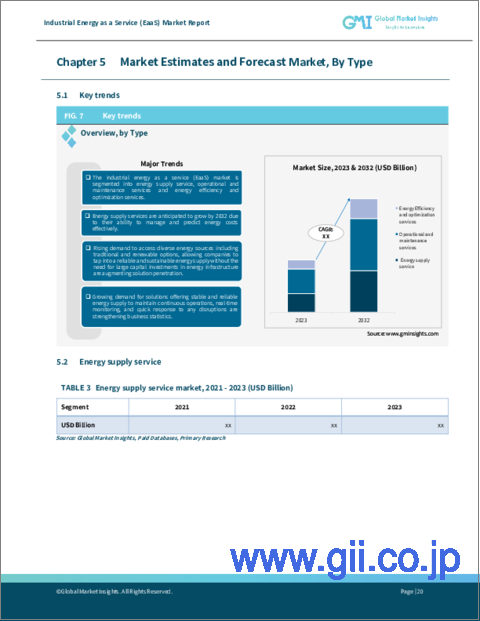|
|
市場調査レポート
商品コード
1573655
産業向けEaaS(Energy as a Service)市場、機会、成長促進要因、産業動向分析と予測、2024年~2032年Industrial Energy as a Service (EaaS) Market, Opportunity, Growth Drivers, Industry Trend Analysis and Forecast, 2024-2032 |
||||||
カスタマイズ可能
|
|||||||
| 産業向けEaaS(Energy as a Service)市場、機会、成長促進要因、産業動向分析と予測、2024年~2032年 |
|
出版日: 2024年08月23日
発行: Global Market Insights Inc.
ページ情報: 英文 50 Pages
納期: 2~3営業日
|
- 全表示
- 概要
- 目次
世界の産業向けEaaS(Energy as a Service)市場は、2023年に483億米ドルと評価され、2024年から2032年にかけて約9%のCAGRで成長すると予測されています。
EaaSにより、エネルギー・プロバイダーは産業界の顧客に包括的なエネルギー・ソリューションを提供できるようになり、多額の先行投資が不要になります。これらのソリューションには、エネルギー供給、管理、最適化サービスが含まれ、すべてが産業運営特有のニーズに合わせて調整されます。同市場は、エネルギー消費を最適化し、無駄を最小限に抑え、エネルギー費用全体を削減するコスト削減ソリューションに対する需要の高まりによって、成長を目の当たりにしています。先進技術は多額の先行投資をすることなく採用され、エネルギー消費の削減と業務効率の改善を通じて、産業企業の競争力強化を可能にしています。
持続可能性が重視され、厳しい環境規制が産業企業をよりクリーンで効率的なエネルギー・ソリューションへと向かわせています。このシフトはビジネスの成長に影響を与えるだけでなく、業界の情勢が進化していることを浮き彫りにしています。さらに、産業事業が拡張性と柔軟性を追求するにつれて、変化する生産ニーズと特定のエネルギー需要に適応するソリューションに対する需要が高まっています。エネルギー管理をアウトソーシングすることで、これらの企業は、複雑なエネルギーシステム管理から解放され、中核となる事業活動に集中することができます。生産性と成長を高めることを目的としたこの戦略的転換が、市場統計を後押ししています。
産業向けEaaS(Energy as a Service)市場は、エネルギー供給サービス、運用・保守サービス、エネルギー効率・最適化サービスの3つのセグメントに分類されます。2032年までに385億米ドルを超えると予測されるエネルギー供給サービスは、エネルギーコストの管理と予測に長けていることから需要が高まっています。伝統的なものから再生可能なものまで、多様なエネルギー源に対する需要が高まっています。この需要により、企業はエネルギー・インフラに多額の設備投資をすることなく、信頼性の高い持続可能なエネルギー供給を確保することができます。さらに、安定したエネルギー供給、継続的な操業、リアルタイムのモニタリング、迅速な障害対応を保証するソリューションが人気を集めています。
アジア太平洋地域のEaaS市場は、2032年までに413億米ドルを突破すると見られています。同地域の急速な産業成長と都市化がエネルギー需要を牽引しており、効率的で持続可能なソリューションが必要とされています。中国、インド、日本などの国々は、クリーンエネルギー技術の採用を促進する政策やインセンティブを打ち出しています。輸入化石燃料への依存度が高いこの地域は、エネルギー安全保障への懸念を高めており、エネルギー源を多様化し、予測不能な世界エネルギー市場への依存を軽減するソリューションの採用をさらに促進しています。
目次
第1章 調査手法と調査範囲
第2章 エグゼクティブサマリー
第3章 業界洞察
- 業界エコシステム
- 規制状況
- 業界への影響要因
- 促進要因
- 業界の潜在的リスク&課題
- 成長可能性分析
- ポーター分析
- PESTEL分析
第4章 競合情勢
- イントロダクション
- 戦略ダッシュボード
- イノベーションとテクノロジーの展望
第5章 市場規模・予測:タイプ別、2021年~2032年
- 主要動向
- エネルギー供給サービス
- 運用・保守サービス
- エネルギー効率化・最適化サービス
第6章 市場規模・予測:地域別、2021年~2032年
- 主要動向
- 北米
- 米国
- カナダ
- メキシコ
- 欧州
- ドイツ
- イタリア
- 英国
- フランス
- デンマーク
- アジア太平洋
- 中国
- タイ
- 韓国
- インド
- 日本
- 世界のその他の地域
第7章 企業プロファイル
- Adven
- Anesco
- Budderfly
- Centrica Business Solutions
- ENGIE Impact
- EDF Energy
- Honeywell International Inc
- Hitachi, Ltd.
- Johnson Controls
- Keppel
- Siemens AG
- Schneider Electric
- WGL Energy
The Global Industrial Energy As a Service (EaaS) Market was valued at USD 48.3 Billion in 2023 and is projected to grow at a CAGR of approximately 9% from 2024-2032. EaaS allows energy providers to offer comprehensive energy solutions to industrial clients, eliminating the need for significant upfront investments. These solutions encompass energy supply, management, and optimization services, all tailored to the unique needs of industrial operations. The market is witnessing growth, driven by a rising demand for cost-saving solutions that optimize energy consumption, minimize waste, and reduce overall energy expenses. Advanced technologies are being adopted without hefty upfront investments, enabling industrial firms to enhance competitiveness through reduced energy consumption and improved operational efficiency.
There's a pronounced emphasis on sustainability, with stringent environmental regulations pushing industrial companies towards cleaner, more efficient energy solutions. This shift not only impacts business growth but also underscores the industry's evolving landscape. Furthermore, as industrial operations seek scalability and flexibility, there's a heightened demand for solutions that adapt to changing production needs and specific energy demands. By outsourcing energy management, these companies can concentrate on core business activities, free from the complexities of energy system management. This strategic shift, aimed at boosting productivity and growth, is driving market statistics.
The overall industrial energy as a service (EaaS) industry is classified based on the type, and region.
The industrial energy as a service (EaaS) market is categorized into three segments: energy supply service, operational and maintenance services, and energy efficiency and optimization services. Energy supply services, projected to exceed USD 38.5 Billion by 2032, are in demand for their prowess in managing and predicting energy costs. There's a growing appetite for diverse energy sources, both traditional and renewable. This demand allows companies to secure a reliable and sustainable energy supply without hefty capital investments in energy infrastructure. Additionally, solutions that ensure a stable energy supply, continuous operations, real-time monitoring, and swift disruption responses are gaining traction.
The Asia Pacific EaaS market is set to surpass USD 41.3 Billion by 2032. The region's rapid industrial growth and urbanization are driving energy demand, necessitating efficient and sustainable solutions. Countries like China, India, and Japan are rolling out policies and incentives to boost clean energy technology adoption. The region's heavy reliance on imported fossil fuels heightens energy security concerns, further propelling the adoption of solutions that diversify energy sources and mitigate dependence on unpredictable global energy markets.
Table of Contents
Chapter 1 Methodology and Scope
- 1.1 Research design
- 1.2 Base estimates and calculations
- 1.3 Forecast model
- 1.4 Primary research and validation
- 1.4.1 Primary sources
- 1.4.2 Data mining sources
- 1.5 Market definitions
Chapter 2 Executive Summary
- 2.1 Industry 360° synopsis, 2021 - 2032
Chapter 3 Industry Insights
- 3.1 Industry ecosystem
- 3.2 Regulatory landscape
- 3.3 Industry impact forces
- 3.3.1 Growth drivers
- 3.3.2 Industry pitfalls and challenges
- 3.4 Growth potential analysis
- 3.5 Porter's analysis
- 3.5.1 Bargaining power of suppliers
- 3.5.2 Bargaining power of buyers
- 3.5.3 Threat of new entrants
- 3.5.4 Threat of substitutes
- 3.6 PESTEL analysis
Chapter 4 Competitive landscape, 2023
- 4.1 Introduction
- 4.2 Strategic dashboard
- 4.3 Innovation and technology landscape
Chapter 5 Market Size and Forecast, By Type, 2021 - 2032 (USD Billion)
- 5.1 Key trends
- 5.2 Energy supply service
- 5.3 Operational and maintenance services
- 5.4 Energy efficiency and optimization services
Chapter 6 Market Size and Forecast, By Region, 2021 - 2032 (USD Billion)
- 6.1 Key trends
- 6.2 North America
- 6.2.1 U.S.
- 6.2.2 Canada
- 6.2.3 Mexico
- 6.3 Europe
- 6.3.1 Germany
- 6.3.2 Italy
- 6.3.3 UK
- 6.3.4 France
- 6.3.5 Denmark
- 6.4 Asia Pacific
- 6.4.1 China
- 6.4.2 Thailand
- 6.4.3 South Korea
- 6.4.4 India
- 6.4.5 Japan
- 6.5 Rest of World
Chapter 7 Company Profiles
- 7.1 Adven
- 7.2 Anesco
- 7.3 Budderfly
- 7.4 Centrica Business Solutions
- 7.5 ENGIE Impact
- 7.6 EDF Energy
- 7.7 Honeywell International Inc
- 7.8 Hitachi, Ltd.
- 7.9 Johnson Controls
- 7.10 Keppel
- 7.11 Siemens AG
- 7.12 Schneider Electric
- 7.13 WGL Energy





